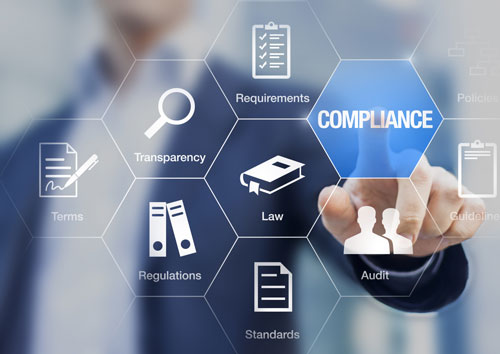ISO 14001 Interested parties - a practical checklist
In this blog, I’ll define the term “interested parties” as relevant to ISO 14001:2015, help you determine who your interested parties could be and provide some practical help so you can comply with the requirements of Clause 4.2 and other requirements related to interested parties in the Standard.
The definition of an interested party
An “interested” party is any individual, organisation or stakeholders that can affect, be affected by, or perceive itself to be affected by your organisation’s decisions or activities.
These may include, for example, customers, community groups, suppliers, external providers, third party services, regulators, non-governmental organisations (NGOs), investors, employees and trade unions.

Who are your relevant interested parties?
Below is a checklist of potential relevant interested parties applicable to your Environmental Management System (EMS), and examples of their needs and expectations.
Bear in mind this list it not exhaustive so be sure to check for others relevant to your management system.
Click here to download this checklist
Click here to download a checklist of interested parties and examples of their needs and expectations.
| Group | Interested parties | Examples of needs/expectations |
| Government | Australian Radiation Protection and Nuclear Safety Agency (ARPANSA) |
|
| Clean Energy Regulator |
|
|
| Environmental authority |
|
|
| Local council |
|
|
| Road authority |
|
|
| Water authority |
|
|
| Your organisation | Employees |
|
| Head office/Parent company |
|
|
| PR Deparment |
|
|
| Shareholders |
|
|
| Other stakeholders | Banks and other credit providers |
|
| Certification auditors |
|
|
| Customers |
|
|
| Electricity provider and services |
|
|
| Insurer |
|
|
| Landlord |
|
|
| Neighbours |
|
|
| Other contractors and suppliers |
|
|
| Trade Unions |
|
|
| Tradespeople working onsite |
|
|
| Waste Contractor |
|

How to comply with ISO 14001’s interested parties’ requirements
This process will help you comply with the legal requirements imposed in Clause 4.2 of the ISO Standard.
Step 1
Once you’ve identified interested parties relevant to your EMS, consider documenting these in a register. (An example of an Interested Parties Register template from our EMS documentation package is provided further in the blog).
For individuals, organisations or stakeholders that “perceive itself to be affected” by your decisions or activities, they need to make that perception known to your organisation before you can document them as an interested party.
Step 2
Determine the needs and expectations of your interested parties.
Identify which of these needs and expectations are relevant and should be adopted as “compliance obligations”. Consider recording the needs and expectations that have become compliance obligations in your register too.
Step 3
Conduct reviews of the information in your register to ensure it maintains accuracy.

Capturing the right information in your register
The implementation of an Interested Parties Register in your management system has numerous advantages to the conformance of other relevant requirements in ISO 14001:2015.
You can capture any information about your identified relevant interested parties in the register that works for your environmental performance or corporate requirements, but at a minimum I suggest including this information:
- Interested party name
- Connection with your organisation
- The interested party’s needs and expectations
- If the need and expectation is a compliance obligation
Here is an example of the Interested Parties Register template included in our documentation package.
Adopting needs and expectations as a compliance obligation
The definition of compliance obligations and their applicable legal requirements relevant to Clause 6.1.3 in the Standard is explained in this blog. Here I just want to briefly summarise how a need and expectation of an interested party becomes a compliance obligation.
Relevant legal requirements, contract requirements or regulatory requirements are automatically mandatory obligations for your organisation.
Non-mandatory obligations include, among other things, the needs and expectations of interested parties.
These become compliance obligations when your organisation deems them relevant to your EMS.

Reviewing the information in your register
Conducting a review of the information in your Interested Parties Register is particularly important when changes to aspects in your Environmental Management System occur or changes to corporate requirements, regulatory requirements or even Council local laws occur.
Changes that could potentially affect your Environmental Management System and subsequently your interested parties, are such things as the expansion of the scope (i.e the physical or organizational boundaries of the management system) or the introduction of new environmental objectives and targets.
You may need to identify new individuals, organisations or stakeholders that affect or can be affected by the changes or determine if any existing parties’ needs and expectations have been directly affected.
A review shouldn’t just happen when changes occur. It is also just as important for a review to be undertaken independent of change. It is best practice to schedule a record regular review of your register, usually every twelve months.

Other requirements in ISO 14001 relevant to interested parties
While Clause 4.2 focuses specifically on interested parties’ requirements, there are other relevant requirements in the Standard that require the consideration of interested parties and their corresponding needs and expectations.
Clause 4.3 (Scope of the Environmental Management System)
Considering the needs and expectations of your relevant interested parties can help to determine the scope of your Environmental Management System.
Clause 5.2 (Environmental policy)
As some parties may require objective evidence of the intended outcomes of your Environmental Management System and environmental performance, the environmental policy needs to be made available to all interested parties.
If the performance data generated from contractors, suppliers, services or other relevant interested parties is essential to your organisation’s environmental performance, then you should consider drafting the environmental policy in consultation with them.
Clause 6.1.2 (Environmental aspects)
For “significant” environmental aspects to be properly identified it can be helpful to consider the needs and expectations of your interested parties.
It is also best practice to consider your interested parties’ needs and expectations when developing and reviewing your environmental aspects and impacts.

Clause 6.1.3. (Compliance obligations)
As previously mentioned, organisation can choose to adopt the relevant needs and expectations of their interested parties as compliance obligations. These are required to comply with the requirements of this clause.
Clause 7.4 (Communication)
Communication of environmental information is specifically required to be appropriate and understandable to the interested party and enable them to participate.
It is also best practice to keep records of this communication.
Clause 8.2 (Emergency response and preparedness)
Interested parties should be given appropriate information and training related to emergency response and preparedness, including those who work under your control.
When checking processes for capturing information about an emergency, ensure a process is in place to promptly disseminate this information to your relevant interested parties.
Clause 9.3 (Management review)
Certain functions and accountabilities are required of top management in relation to the Environmental Management System including conducting regular management reviews to ensure the continued suitability and effectiveness of the system. Part of this review includes management considering any changes to the needs and expectations of interested parties, and communication from interested parties including complaints.